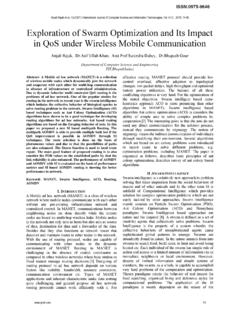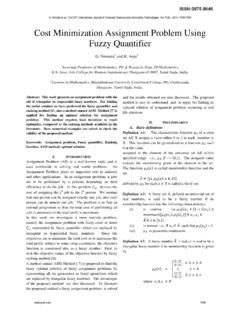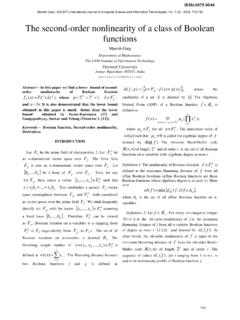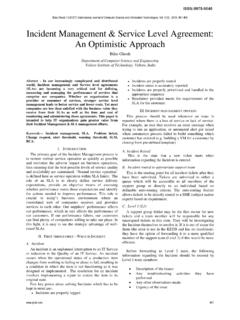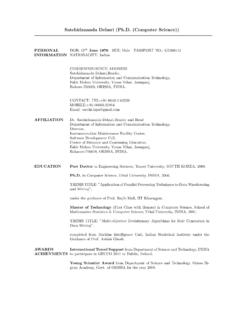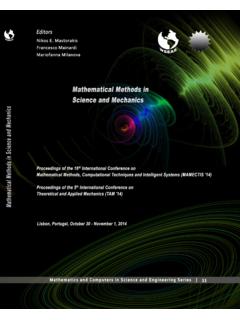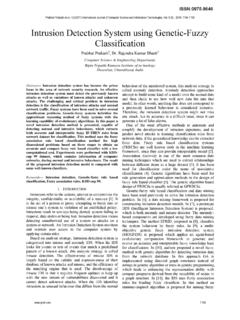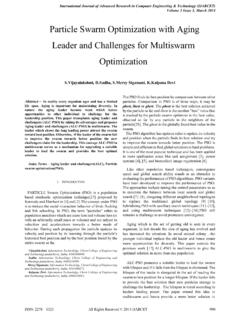Transcription of Multi-Objective Sentiment Analysis Using …
1 Multi-Objective Sentiment Analysis Using evolutionary algorithm for Mining Positive & Negative Association Rules Swati V. Gupta1, Madhuri S. Joshi2 1,2 Department of Computer Science & Engineering, MGM s Jawaharlal Nehru Engineering College, N-6 CIDCO, Aurangabad - 431003, M. S., India Abstract- Most of the algorithms for mining Quantitative Association Rules (QAR) focuses on positive dependencies without paying particular attention to negative dependencies. The latter may be worth taking into account, however, as they relate the presence of certain items to the absence of others.
2 The algorithms used to extract such rules usually consider only one evaluation criterion in measuring the quality of generated rules. Recently, some researchers have framed the process of extracting association rules as a multiobjective problem, allowing us to jointly optimize several measures that can present different degrees of tradeoff depending on the dataset used. In this paper, a Multi-Objective Sentiment Analysis is done Using evolutionary algorithm (EA) for mining positive & negative Association rules.
3 It is an important methodological application in the world of Data Mining (DM). This paper includes the approach and technique of Multi-Objective Positive Negative Association Rule (MOPNAR) based predictive Sentiment Analysis , which is based on huge dataset of multiple opinion obtained. In this study multiple opinions from customer, data analyst, writers, and composers has been used which are in the form of text for identification of predictive sentiments. Index Terms- MOPNAR, Multi-Objective Sentiment Analysis , Opinion Mining, Sentiment Analysis .
4 I. INTRODUCTION From the last decade, the digital revolution has provided relatively inexpensive and accessible means of collecting and storing data. This unlimited growth of data has led to a situation in which the knowledge extraction process is more difficult and, in most cases, leads to problems of scalability and/or complexity [2]. Association discovery is one of the most common data mining techniques used to extract interesting knowledge from large datasets [3]. Association rules are used to identify and represent dependencies between items in a dataset [4].
5 Multi-Objective Sentiment Analysis and predictive mining is the field of study that analyzes people's opinions, sentiments, evaluations, attitudes, and emotions from written language. It is one of the most active research areas in Natural Language Processing (NLP) and is also widely studied in data mining, Web mining, and text mining. In fact, this research has spread outside of computer science to the management sciences and social sciences due to its importance to business and society as a whole.
6 The growing importance of Sentiment Analysis coincides with the growth of social media such as reviews, forum discussions, blogs, micro-blogs, Twitter, and social networks. For the first time in human history, now a huge volume of data is available which is known as opinionated data and that data is recorded in digital form for Analysis . Multi-Objective Sentiment Analysis systems are being applied in almost every business and social domain because opinions are central to almost all human activities and are key influences of people behaviors.
7 People beliefs and perceptions of reality, and the choices make by the user, are largely conditioned on how others see and evaluate the world. For this reason, when person need to make a decision they often seek out the opinions of others. This is true not only for individuals but also for organizations. In this paper, focus is on implementation of a new Multi-Objective evolutionary algorithm (MOEA) with positive negative Association rule to achieve a new learning of characteristics and a condition selection for each rule, while presenting an exterior population (data) and a resuming process to store all the non- conquered rules found and to recover the variety of the rules.
8 This proposal introduces an evolutionary Process (EP) and a restarting process to the evolutionary model in order to store all the non-dominated rules found and to improve the variety of the rule set obtained. There are numerous methods to changing the Multi-Objective optimization problem into a number of scalar optimization problems. This produces an optimized approach to understand from a user s standpoint, and with extraordinary values for the interestingness events in all information contents. : POSITIVE AND NEGATIVEQUANTITATIVE ASSOCIATION RULES Many previous studies for mining association rules have focused on datasets with binary or discrete values; however, the data in real-world applications usually consists of quantitative values.
9 The association rules obtained from datasets with quantitative values is known as QARs, where each item is a pair attribute-interval [7]. For instance, a positive QAR could be Age {30, 52} and Salary {3000, 3500} NumCars {3, 4}. Swati V. Gupta et al, / (IJCSIT) International Journal of Computer Science and Information Technologies, Vol. 7 (3) , 2016, of these algorithms have only focused on positive rules, , only those item sets appearing frequently together will be discovered. However, the negative association rules may also be interesting as they offer information that could be used to support decisions for applications.
10 Negative association rules consider the same sets of items as positive association rules but may also include negated items within the antecedent ( X Y) or the consequent (X Y) or both ( X Y) [8]. For instance, a simple example of a negative QAR is Weight {15, 30} and Height {90, 150} Age {4, 28}. Notice that, positive association rules only include positive items whereas negative association rules include at least one negative item. Fig. 1 shows the domain of the positive item Height {90, 150} and the negative item Age {4, 28}.
